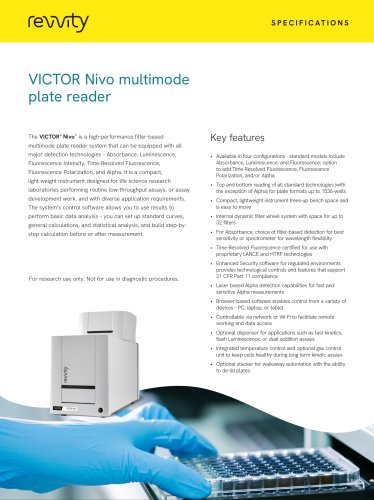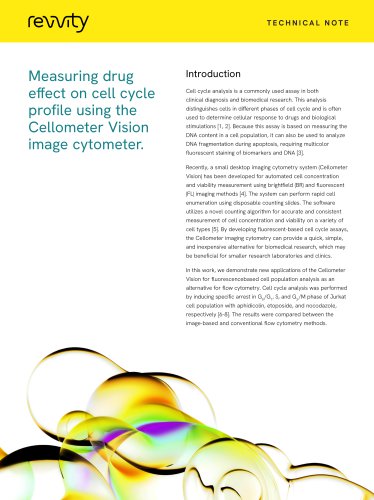 Website:
revvity
Website:
revvity
Group: PerkinElmer
Catalog excerpts

TECHNICAL NOTE PhenoPlate 384-well dedicated design for high content screening. Authors Heidi Morgan Stefan Letzsch Rob van Beurden Revvity, Inc. Background High content screening (HCS) and high content analysis (HCA) are imaging-based multi-parametric approaches of cell analysis that can be used for a broad range of applications in life science research, including target identification, primary and secondary screening, safety assessment, and systems biology. Imaging cultured cells using high resolution fluorescence and/or brightfield microscopy in a high-throughput manner with a high-content screening system, requires the use of high quality microplates. The better quality of the plate leads to a better quality image, thus more predictive of true biology and clinical disease research. Features and benefits: • Ultra-low plate bottom (200 pm) • All well access when using water immersion and high NA objectives • Excellent plate bottom flatness • Optimal clarity and fast autofocusing • Superior image quality with bottom made of cyclic olefin • Reduced evaporation due to special design, low profile plate lid • Unique corner spacers avoid damaging the imaging surface when stacking without lid • Suitable for various applications • Available with different coatings
Open the catalog to page 1
PhenoPlate 384-well dedicated design for high content screening. Figure 1: PhenoPlate 384-well features an ultra-low plate bottom, reduced evaporation rate with low profile lid, and unique corner spacers for ease of stacking plates with or without lid. Based on many years of applications development in high image, it is quite expensive. Using the PhenoPlate 384-well content screening and an in-depth understanding of the with cyclic olefin (CO) bottom material, Figure 2 shows requirements needed for improved data quality, Revvity’s sharp and focused cellular images from the Opera Phenix®...
Open the catalog to page 2
PhenoPlate 384-well dedicated design for high content screening. in higher image quality. The newly designed thin and flat the side view of a PhenoPlate 384-well and the optimized CO bottom of the plate allows generation of better images ultra-low plate bottom. This new design reduces the bottom in combination with the superior optical clarity of the CO height to an ultra-low level (200 μm). This shows that with material used, and is comparable to that of glass and is the enhanced ultra-low bottom design, more images can better than standard polystyrene. be acquired and more data generated...
Open the catalog to page 3
PhenoPlate 384-well dedicated design for high content screening. Figure 3: Flatness of plate bottom. Panel A shows a 384-well plate with a standard polystyrene bottom (PS), panel B shows a 384-well plate with a standard glass bottom (GB), and panel C shows a PhenoPlate 384-well with a cyclic-olefin bottom (CO). Panel D represents measurement of bottom height in positions 1 to 4 for each well. The difference value between the maximal and minimal bottom height in each well was calculated and plotted for each well and plate type. Values higher than 10 microns (red area) can result in unfocused...
Open the catalog to page 4
PhenoPlate 384-well dedicated design for high content screening. Common 384-well plate with Figure 5: Evaporation measured over 24 hour incubation period (37 °C, 5% CO2) comparing a standard plate with the PhenoPlate 384-well filled with 40 μL water. The graph in panel A illustrates the evaporation in a standard 384-well plate with a regular lid and the graph in panel B illustrates a PhenoPlate 384-well with the newly designed low profile lid. The low profile lid shows significantly decreased volume reduction in outer wells. Conclusions In this technical note, we have shown that 384-well...
Open the catalog to page 5All Revvity catalogs and technical brochures
-
Model 307 Sample Oxidizer
3 Pages
-
chemagic Prepito® instrument
4 Pages
-
chemagic 360 instrument
4 Pages






















